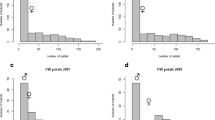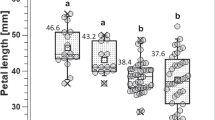Abstract
A segregating population of diploid rose hybrids (2n = 2x = 14) was used to construct the first linkage maps of the rose genome. A total of 305 RAPD and AFLP markers were analysed in a population of 60 F1 plants based on a so-called ”double-pseudotestcross” design. Of these markers 278 could be located on the 14 linkage groups of the two maps, covering total map lengths of 326 and 370 cM, respectively. The average distances between markers in the maps for 93/1–117 and 93/1–119 is 2.4 and 2.6 cM, respectively. In addition to the molecular markers, genes controlling two phenotypic characters, petal number (double versus single flowers) and flower colour (pink versus white), were mapped on linkage groups 3 and 2, respectively. The markers closest to the gene for double flowers, Blfo, and to the gene for pink flower colour, Blfa, cosegregated without recombinants. The maps provide a tool for further genetic analyses of horticulturally important genes as, for example, resistance genes and a starting point for marker-assisted breeding in roses.
Similar content being viewed by others
Author information
Authors and Affiliations
Additional information
Received: 22 September 1998 / Accepted: 12 March 1999
Rights and permissions
About this article
Cite this article
Debener, T., Mattiesch, L. Construction of a genetic linkage map for roses using RAPD and AFLP markers. Theor Appl Genet 99, 891–899 (1999). https://doi.org/10.1007/s001220051310
Issue Date:
DOI: https://doi.org/10.1007/s001220051310




